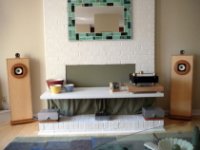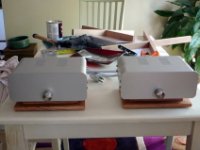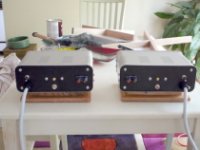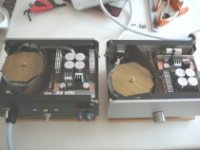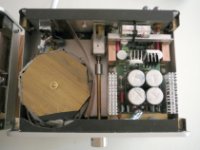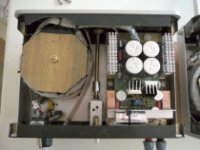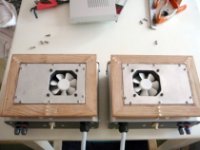Thats what I use in my AAK amp,works fine.I would recommend you to take mje15034/15035
Just have to fix that output transistor....

roender said:I would recommend you to take mje15034/15035, the best drivers available for 0302/0281
Thanks:
It is getting a bit murky with all the combos.
As the MJE15030/31 are unobtainium material.
With MIkeb. Pavel, Ryssen,AAK,MBK.... we have the favourite transistor of the week?day?.
I will have voltage closer to 42-45 so was NOT going to use Q1 & Q2 as MPSA18 but BC547C the higher gain would hopefully
get away from MBK probleem as startup thump.
Although I will install softstart in anycase.
Guys,
Its finally singing. 🙂 Listen for two hours till midnight. Only listen with 33pF at both C2 and C7 at the moment. Transformer is 18V-0-18V (150VA) for both channel. It's very good, no doubt. Even with my puny tranny, the bass is so much well controlled, much better than GC that I'm familiar with. This beast like to be pushed hard because it does not sound strain at high volume. The only niggle at this moment is the high can sometime become too splashy at high volume especially for cymbal and hand clapping. I suspect it might have to do with C2 and C7. Will test out MikeB original value later tonight. Thanks you all for the effot to come up with this good amp.
Hi MBK,
You are correct. No point saving small $ for much trouble. I've just burned R4 on one channel when I test my amp with 100KHz input. So I just remove R4.
Must I use an active preamp for this amp?
Hi Anatech,
No choice then. I will invest in a THD meter. 🙂
Thanks.
Its finally singing. 🙂 Listen for two hours till midnight. Only listen with 33pF at both C2 and C7 at the moment. Transformer is 18V-0-18V (150VA) for both channel. It's very good, no doubt. Even with my puny tranny, the bass is so much well controlled, much better than GC that I'm familiar with. This beast like to be pushed hard because it does not sound strain at high volume. The only niggle at this moment is the high can sometime become too splashy at high volume especially for cymbal and hand clapping. I suspect it might have to do with C2 and C7. Will test out MikeB original value later tonight. Thanks you all for the effot to come up with this good amp.
Hi MBK,
You are correct. No point saving small $ for much trouble. I've just burned R4 on one channel when I test my amp with 100KHz input. So I just remove R4.
Must I use an active preamp for this amp?
Hi Anatech,
No choice then. I will invest in a THD meter. 🙂
Thanks.
Hi,Ipanema said:.....Only listen with 33pF at both C2 and C7 at the moment. ..............The only niggle at this moment is the high can sometime become too splashy at high volume especially for cymbal and hand clapping. I suspect it might have to do with C2 and C7. Will test out MikeB original value later tonight. .............
Must I use an active preamp for this amp?
get that compensation sorted before you blow up the amplifier. If it oscillates with a highly reactive cable/speaker combination it can take out the output devices very quickly.
Active/buffered pre-amp/volume control is good.
10k passive pre is much better than 50k.
If your source can drive a lower impedance passive pre well , then try 2k or 5k for the volume pot.
Hi Mike,
I resemble that remark! 😱
Hi Ipanema,
-Chris
I resemble that remark! 😱
Hi Ipanema,
You will be pleased once you have one.No choice then. I will invest in a THD meter. 🙂
You need to include R4, you really do.So I just remove R4.
I would ... for so many reasons. Whether it has gain or not is unimportant. It must have a low output impedance.Must I use an active preamp for this amp?
-Chris
A Sym-a-sym for Dummy.
It seems a long time ago that I dumpstered the SET monoblocs that in five years had spent more time on the bench than playing music, and began the process of building a set of hopefully less costly and more reliable solid state amps. I’d heard about the sym-a-sym on the chip amp forum, and was impressed to learn from those who’d built both designs that in comparison to a chip amp the sym-a-sym was substantially better sounding. So, after successfully building a copy of Peter Daniel’s Patek and finding it to be a very good sounding amp I decided to give a pair of sym-a-sym monoblocs a try.
I had not, however, anticipated how much work was involved in designing and building (with hand tools) small, mirror-imaged enclosures, nor how frustrating and expensive my ignorance of ee principles would turn out to be. For example, I bought a new set of RFI and EMI-shielded Plitrons, only to discover that they were critically underpowered and had to be replaced. And never, ever let a computer salesnerd convince you that a thermal interface material designed for CPUs is electrically non-conductive.
At any rate, at some point during the process I decided that as long as I was expending so much time, effort and money on what are to be my last (and only) amps, I’d complement Al’s adaptation of Mike’s superb circuit with the most musical sounding parts I‘ve come across in many years of tweaking. So, in populating Al’s board I made the following modifications to his BOM:
1) 5 watt Kiwame carbon film resistor at R4;
2) 5 watt Mills wirewound resistors at R27, R28, R37 and R38;
3) 0.5 watt Audio Note tantalum resistor at R13;
4) 0.5 watt Shinkoh tantalum resistors at R12, R14, R29 and R30;
5) 2 watt Kiwame resistors everywhere else they’d fit on the amp
side of the board;
6) 500V Miconics silver mica caps, with a 5pF cap at C14;
7) V Cap OIMP cap at C1;
8) Rubycon ZL caps at C8, C9 and C19; and
9) 10A, 300V CREE Schottky diodes at D1, D2, D3 and D4.
Finally, I matched all resistors, transistors and small value capacitors within and/or across channels.
The chassis of each monobloc is a modified (shortened by 50% and reinforced) ATI 737. The transformer is a 2 X 33V, 300VA Plitron, shielded with Stillpoints ERS cloth, a TI Shield EMI band and a 4” octagonal, 1/4” thick brass top “washer.” The ouput heatsink is a 4” by 6 3/4” by 1/4” brass flat with 20 computer PLL heatsinks bonded to each longitudinal bottom edge with Artic Alumina. Bonded to each top longitudinal edge are 1” and 1 1/2” by 1/2” copper heat spreaders topped by more chipset heatsinks, and the whole Rube Goldberg assembly floats on nylon pylons over four 11/16” holes punched in the bottom of the chassis along the heatsink’s longitudinal midline.
The oak pedestal is actually a plenum chamber with an 80mm Nexus brushless DC fan mounted to its bottom surface. This noiseless fan draws cool air from underneath the edges of the pedestal and forces twenty cubic feet of it a minute through the 11/16” holes and into the chassis through the inverted pins of the PLL sinks. With the amp biased at about 30mv when idle, the heatsink gets only moderately warm after extended high-volume play.
The driver heatsinks are made from 3/4” by 1/8” aluminum stock and Radio Shack TO-220 sinks. The RCA jack is a silver CMC and the posts are Eichmann Cable Pods. The input cable is a twisted, 3” long, two-wire bundle of 22 gauge Cardas solid silver wire and the output cable is a twisted bundle of four 4” lengths of the same wire. The volume control is a Scott Endler shunt attenuator using a 20K Audio Note tantalum as the series resistor. The dedicated AC cable is Supra LoRad and is connected to the transformer through a 15A Carling DPST switch. The stainless knob is from DACT and is mounted on a brass shaft extension using a modified Wellborne Labs extender kit. Grounded copper braid tubing and TI Shield is used elsewhere wherever I thought shielding might be helpful. Hardware is either brass or stainless steel. Joints are all tight mechanical contact reinforced with Wonder Solder (a bitch to remove, but worth it, in my opinion).
The links are to pictures of the amps in-line with the rest of my system, which consists of a modified Meridian 500 transport, a high-resolution, high-output d’Ack 2.0, and a set of full range, hybrid BLH/TL speakers with bamboo cabinets built by Chris Bobiak using Tom Zurowski’s PAWO design. Drivers are matched and modified Fostex 127s supplemented by Fostex T90A supertweeters crossed first order at 40K. (I’ll soon post links to more pictures of the speakers in the Full Range forum.) A PS Audio UPC-200 provides protection and AC conditioning for the amps and an Ultimate Outlet provides conditioning for the transport. All connections are made with Stereovox Studio Series cables, the only commercial cables I’ve tried (and the first I’ve ever bought) that sound better in every respect than the litz-weave cables I made for years with CCC magnet wire.
When I first connected the amps to the speakers with their inputs shorted, there was no hiss, hum or noise of any kind. And I mean none, not even with my ear against the cone and the volume control cranked to maximum. I thought the amps weren’t working. Again. So, I fixed myself a drink and sat on the sofa, staring at them, very nearly despondent. Then, somewhere on the road to Margaritaville I decided what the hell and wired the whole train wreck together and spun up Keb Mo’s “The Door.” Immediately I was transported to The Valley, where a chorus of blonde cheerleaders whispered, all in unison,” Oh.My.God.”
That was weeks ago, and while the system sounded very good then it’s remarkably better sounding now. Actually, it’s incredible. I’m being treated to the most dynamic, focused, timbrally accurate and resolved (while at the same time “relaxed”) approximation of a recorded event I’ve ever heard. And, like no other system I’ve put together, including one employing the cursed SETs or even my beloved triode-wired Quicksilvers (which I still kick myself for selling in order to buy the SETs), the approximation is so immediate and “real” that when I play a good vocal recording my dogs growl and slink out of the room. Is it speed, phase coherence, timbral fidelity, resolution and micro-dynamics? Frankly, I don’t care. Keb, Diana, Lyle, whomever, they’re in the room, although I must confess that I am able to attend to sonics for no more than fifteen seconds before being seduced by the music. But, then again, isn’t that the point?
I really can’t express how thankful I am to Mike, Al and Ryssen for their efforts and to everyone on the forum who provided me with essential (and probably life-saving) advice. But, thanks anyway.
Dummy happy.
BTW, since this concludes my journey through Diyland, tomorrow I’ll post for sale on the Market Place forum an embarrassingly large selection of leftover parts, meters and tools.
It seems a long time ago that I dumpstered the SET monoblocs that in five years had spent more time on the bench than playing music, and began the process of building a set of hopefully less costly and more reliable solid state amps. I’d heard about the sym-a-sym on the chip amp forum, and was impressed to learn from those who’d built both designs that in comparison to a chip amp the sym-a-sym was substantially better sounding. So, after successfully building a copy of Peter Daniel’s Patek and finding it to be a very good sounding amp I decided to give a pair of sym-a-sym monoblocs a try.
I had not, however, anticipated how much work was involved in designing and building (with hand tools) small, mirror-imaged enclosures, nor how frustrating and expensive my ignorance of ee principles would turn out to be. For example, I bought a new set of RFI and EMI-shielded Plitrons, only to discover that they were critically underpowered and had to be replaced. And never, ever let a computer salesnerd convince you that a thermal interface material designed for CPUs is electrically non-conductive.
At any rate, at some point during the process I decided that as long as I was expending so much time, effort and money on what are to be my last (and only) amps, I’d complement Al’s adaptation of Mike’s superb circuit with the most musical sounding parts I‘ve come across in many years of tweaking. So, in populating Al’s board I made the following modifications to his BOM:
1) 5 watt Kiwame carbon film resistor at R4;
2) 5 watt Mills wirewound resistors at R27, R28, R37 and R38;
3) 0.5 watt Audio Note tantalum resistor at R13;
4) 0.5 watt Shinkoh tantalum resistors at R12, R14, R29 and R30;
5) 2 watt Kiwame resistors everywhere else they’d fit on the amp
side of the board;
6) 500V Miconics silver mica caps, with a 5pF cap at C14;
7) V Cap OIMP cap at C1;
8) Rubycon ZL caps at C8, C9 and C19; and
9) 10A, 300V CREE Schottky diodes at D1, D2, D3 and D4.
Finally, I matched all resistors, transistors and small value capacitors within and/or across channels.
The chassis of each monobloc is a modified (shortened by 50% and reinforced) ATI 737. The transformer is a 2 X 33V, 300VA Plitron, shielded with Stillpoints ERS cloth, a TI Shield EMI band and a 4” octagonal, 1/4” thick brass top “washer.” The ouput heatsink is a 4” by 6 3/4” by 1/4” brass flat with 20 computer PLL heatsinks bonded to each longitudinal bottom edge with Artic Alumina. Bonded to each top longitudinal edge are 1” and 1 1/2” by 1/2” copper heat spreaders topped by more chipset heatsinks, and the whole Rube Goldberg assembly floats on nylon pylons over four 11/16” holes punched in the bottom of the chassis along the heatsink’s longitudinal midline.
The oak pedestal is actually a plenum chamber with an 80mm Nexus brushless DC fan mounted to its bottom surface. This noiseless fan draws cool air from underneath the edges of the pedestal and forces twenty cubic feet of it a minute through the 11/16” holes and into the chassis through the inverted pins of the PLL sinks. With the amp biased at about 30mv when idle, the heatsink gets only moderately warm after extended high-volume play.
The driver heatsinks are made from 3/4” by 1/8” aluminum stock and Radio Shack TO-220 sinks. The RCA jack is a silver CMC and the posts are Eichmann Cable Pods. The input cable is a twisted, 3” long, two-wire bundle of 22 gauge Cardas solid silver wire and the output cable is a twisted bundle of four 4” lengths of the same wire. The volume control is a Scott Endler shunt attenuator using a 20K Audio Note tantalum as the series resistor. The dedicated AC cable is Supra LoRad and is connected to the transformer through a 15A Carling DPST switch. The stainless knob is from DACT and is mounted on a brass shaft extension using a modified Wellborne Labs extender kit. Grounded copper braid tubing and TI Shield is used elsewhere wherever I thought shielding might be helpful. Hardware is either brass or stainless steel. Joints are all tight mechanical contact reinforced with Wonder Solder (a bitch to remove, but worth it, in my opinion).
The links are to pictures of the amps in-line with the rest of my system, which consists of a modified Meridian 500 transport, a high-resolution, high-output d’Ack 2.0, and a set of full range, hybrid BLH/TL speakers with bamboo cabinets built by Chris Bobiak using Tom Zurowski’s PAWO design. Drivers are matched and modified Fostex 127s supplemented by Fostex T90A supertweeters crossed first order at 40K. (I’ll soon post links to more pictures of the speakers in the Full Range forum.) A PS Audio UPC-200 provides protection and AC conditioning for the amps and an Ultimate Outlet provides conditioning for the transport. All connections are made with Stereovox Studio Series cables, the only commercial cables I’ve tried (and the first I’ve ever bought) that sound better in every respect than the litz-weave cables I made for years with CCC magnet wire.
When I first connected the amps to the speakers with their inputs shorted, there was no hiss, hum or noise of any kind. And I mean none, not even with my ear against the cone and the volume control cranked to maximum. I thought the amps weren’t working. Again. So, I fixed myself a drink and sat on the sofa, staring at them, very nearly despondent. Then, somewhere on the road to Margaritaville I decided what the hell and wired the whole train wreck together and spun up Keb Mo’s “The Door.” Immediately I was transported to The Valley, where a chorus of blonde cheerleaders whispered, all in unison,” Oh.My.God.”
That was weeks ago, and while the system sounded very good then it’s remarkably better sounding now. Actually, it’s incredible. I’m being treated to the most dynamic, focused, timbrally accurate and resolved (while at the same time “relaxed”) approximation of a recorded event I’ve ever heard. And, like no other system I’ve put together, including one employing the cursed SETs or even my beloved triode-wired Quicksilvers (which I still kick myself for selling in order to buy the SETs), the approximation is so immediate and “real” that when I play a good vocal recording my dogs growl and slink out of the room. Is it speed, phase coherence, timbral fidelity, resolution and micro-dynamics? Frankly, I don’t care. Keb, Diana, Lyle, whomever, they’re in the room, although I must confess that I am able to attend to sonics for no more than fifteen seconds before being seduced by the music. But, then again, isn’t that the point?
I really can’t express how thankful I am to Mike, Al and Ryssen for their efforts and to everyone on the forum who provided me with essential (and probably life-saving) advice. But, thanks anyway.
Dummy happy.
BTW, since this concludes my journey through Diyland, tomorrow I’ll post for sale on the Market Place forum an embarrassingly large selection of leftover parts, meters and tools.
Attachments
Hi Colescuttle, i am happy that you are pleased with Symasym! 🙂
Thanks for your detailed experience and building description, also thanks to AAK for managing the group buy for his nice pcbs.
Mike
Thanks for your detailed experience and building description, also thanks to AAK for managing the group buy for his nice pcbs.
Mike
I'm annoyed. My car transmission has developed a strange clunking noise, so will have to go in and be repaired. Bang goes my parts budget for this month...
😉Ryssen, i am terribly sorry,
Should be:I will have to repair it..much cheaper..😀 😉so will have to go in and be repaired.
pinkmouse said:I'm annoyed. My car transmission has developed a strange clunking noise, so will have to go in and be repaired. Bang goes my parts budget for this month...
FWD? RWD? MAKE? AUTO? MANUAL? under what conditions show problem?
Could be Universal joints and not transmission, If Auto is fluid level OK?
there may be members with experience, can help.
It is automatic, but was serviced only a month or so ago by a garage I trust, so I doubt it is a fluid problem. Could be the universal joints, it was too dark when I got home to check. I'm sure there are members here who could help me fix it, but I have nowhere to work, I live in a terraced house that fronts directly onto the road and even if local byelaws didn't prohibit working on vehicles in the street it would be far too dangerous as it is a busy road. Such is life...
Anyway, we should get back to the topic at hand. 🙂
Anyway, we should get back to the topic at hand. 🙂
- Home
- Amplifiers
- Solid State
- Symasym 5.3 "AAK model" builder's thread
 ...
...